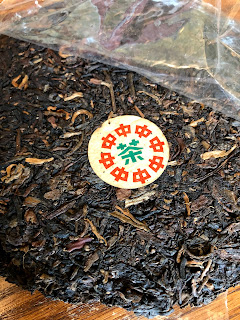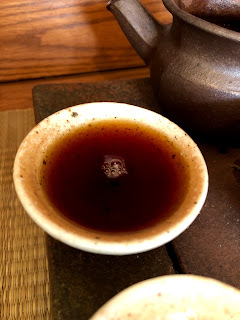If you are really trying to confirm the authenticity of an
aged puerh, you got to sample it for yourself first. You should never buy blindly. Although, a vendor might give you some misinformation, the taste rarely lies and the qi almost never does. As long as you have some experience with
these things as a comparison you can generally or roughly confirm its
authenticity based on trying the tea.
This is how I realized that it is likely the real deal.
When initially trying this tea I assumed it was not what it
is. Two things about this initial sampling
changed my mind. Firstly, it had an aged
storage taste to it that can’t really be faked.
Second, it had big qi both in a strong sensation in the body and very
mellow sensation in the mind that is a signature of old puerh. This is the type of feeling I get and is
common among old tea before the times of plantation mao cha. Although younger puerh can have sensations
similar to this, it is not the same, but hard to put into words. It’s almost as if the qi of older puerh is
deeper level qi and very good quality young puerh qi is more superficial. This
tea had some of the former.
After the qi tipped me off, I began to research online what others experience of the Guang Yun Gong qi felt like and it somewhat
matched what I was experiencing. So the
first thing I did was research what the qi sensation of the Guang Yun Gong
series, specifically the 1970s bing.
Below are some specific notes I took from a session a few
weeks ago…
I really pack the dry leaves into a pot for a strong
infusion early this morning pushing this tea more than I have to date. I’m looking for a bit of a boost half asleep
this morning. This is going to be a bit
on the stronger side, I think to myself.
The dry leaf smells of faint distant herbal medicines and is
rather inert smelling.
Rinse opens the tea up to dusty, sweet fruit, hay, and
legumes there is a creamy dry stored sweet fragrant odor in there as well as
some storage notes of dustiness and even distant medicinal smells.
The first infusion pours a browny, slight reddish and delivers
a rich initial slightly bitter taste of roasted legumes and beans, it’s almost
coffee-like then there is a slowly evolved transition of a molasses-like
sweetness which turns into a talc like strawberry sweetness which lingers long
on the breath and in the mouth along with a cool finish in the mouth. The mouthfeeling is sticky and slightly
astringent especially the tongue surface and roof of the mouth. The throat opening is deep but mild.
The second infusion packs another powerful taste
package. The initial taste is almost
coffee-like thick dense molasses sweetness with a beany slightly bitter
edge. There is more storage taste in the
middle profile of faint herbals underneath the sweet syrupy taste. The finish is of talc very sweet strawberry
notes in camphor. The mouthfeel has a
strong sticky coating in the mouth. The
qi is big, strong, immediately clearing but very very relaxing. It is more deep and mellowing than it is
strong in the body.
The third infusion delivers a slightly bitter, dense earth/
dirt tasting initial taste which turns into a bean and earth taste which then
shifts to a very syrupy sweet taste. It
finishes with a talc light fruity and mineral sweetness. Even minutes later there is the finishing
taste over top a deeper dense beany note.
The fourth infusion is getting more dense and syrupy in its
initial taste. The initial taste is now
a syrupy sweet almost maple syrup and molasses taste then the bean taste
develops with medicinal notes. The
returning sweet taste is less here but still significantly menthol, slight
mineral, slight fruit. The mouthfeel
becomes more astringent and dry here.
The qi is significant and makes the head wobble.
The fifth is becoming more beany and bitter and less syrupy,
sweet, nuanced. The flavor starts to coalesce
as the beany tastes dominates and more storage notes of medicinal herbs are
more obvious in the middle profile. The
taste still evolves throughout the profile but is more dominated by a bean, legume,
slightly bitter taste. The aftertaste
remains cooling and sweet, slightly talc.
The sixth is much the same as the base flavor now spreads
all the way through the profile now. As
the thick beany taste covers the profile and the taste becomes slightly
bitter. The lighter notes become less
distinct now.
The seventh infusion has a talc mineral cherry like
sweetness veiled in bean and woody tastes.
The mouthfeel is grainy and thick and the aftertaste is cooling. The beany, woody, almost dirt like taste is
dominant.
The eighth infusion tastes dusty and old storage initially
with a long beany slightly astringent undertone. The dusty storage taste is predominating here
now with the bean, wood, earth taste underneath. The coolness is still obvious in the breath
but the sweetness here is substantially less.
The ninth infusion has a bean and bitter dirt like taste
with a woody profile underbelly. The
sweetness is not present to offer a polarity in the initial taste which is a
touch off putting. In the aftertaste it
emerges as a light cooling sweetness.
This tea is fading quickly now.
The tenth infusion has a cooling bitter woody bean initial
taste with a pungent coolness up front and lingering into the aftertaste. The sweetness is becoming less apparent
underneath the dirt, aged taste and bitter astringency.
The eleventh is starting to get a touch watery in its
initial taste. It opens up the profile
to more minerality and sweetness. A
faint fruity sweetness lingers on the breath.
The twelfth, thirteenth, fourteenth infusions are much the
same. With each infusion comes a
thinner, more watered down taste. The
medicinal herbal notes from storage are also the most apparent here which, to
me, are interesting to imbibe.
Overall, this session was a bit stronger and rougher than my
other sessions with this tea. I have had
about 5 sessions with this tea experimenting with different brewing vessels,
amount of dry leaf, and steeping time.
It seems to do well with pots with a very quick pour and a little less
leaves than I normally use. Flash
infusions for the first 10 infusions then longer. This seems to string out the best of this tea
which resides in the first infusion’s high notes and last infusions aged notes. It can get a touch nasty in the middle especially
when steeped too aggressively. When this
happens a bitter, astringent, beany dirt like taste emerges as we saw in this
session. If too little leaf is used you
don’t get as nice depth of flavor in the first handful of infusions. So this tea can be a testy one to drink for
sure. It’s good up to about 12-14
infusions.
Overall, this tea carries significant aged storage
notes. These notes resemble longer dry
storage recently but the deeper dirt tastes suggest more humid storage at the
first years in storage. This tea kind of
tastes like a mix of the following: lightly fermented shu puerh, dry stored
sheng puerh, and hei cha similar to a fu brick.
It is a very unique and unusual beast!
Peace







Hi Matt,
ReplyDeleteFinally the verdict! :) I'm glad to hear. I wanted to ask you if you think it's puer or some tea leaves from another region were used.
Curigane/Tiago
I suspected it already ;)
ReplyDeleteCurigane,
ReplyDeleteThink I would write out all these posts if it was just a fake... no way. Hahaha
These bings used material from other areas, I suspect. It tastes kind of hei cha- like.
Peace
Ahahah :) anyway I am very happy to hear. :)
ReplyDelete